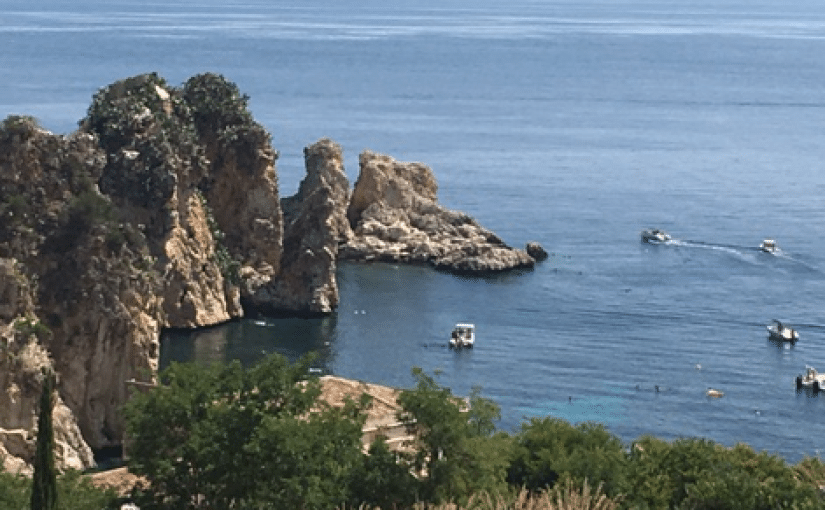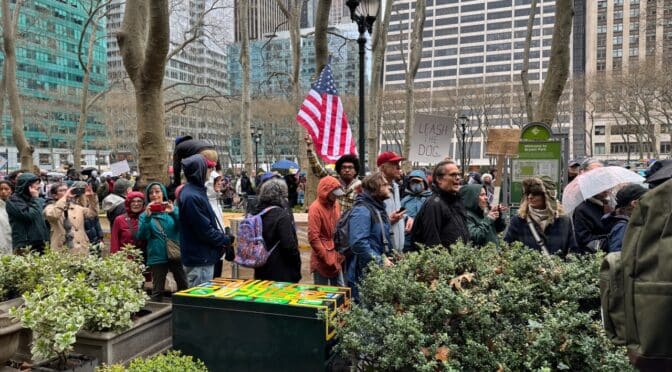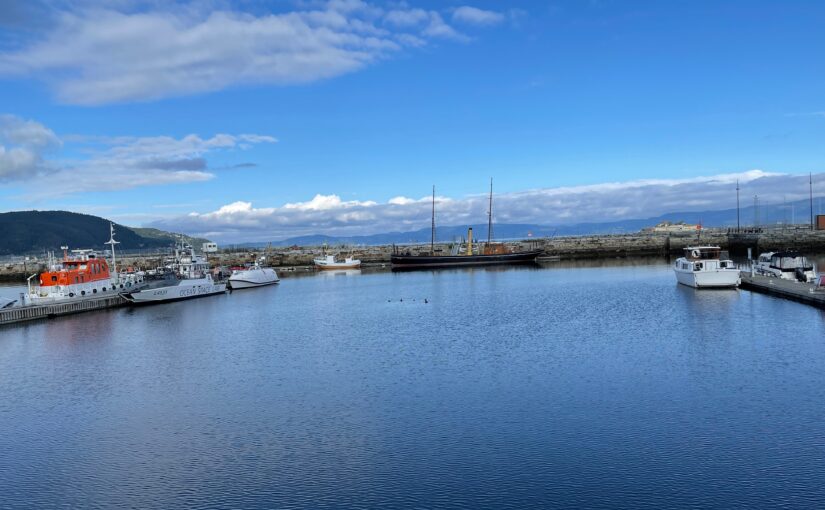by Nick Taylor and Barbara Nevins Taylor
Our dive into history and search for romance took us from Selinunte and the Temple of Hera to new destinations.
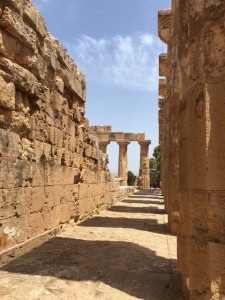
First we headed west hugging the Sicilian coast.
We could have joined the autostrada at Castelvetrano, but the appeal of the blue Mediterranean tugged at us. We went through Mazara del Vallo and then Marsala where the road turned north to Trapani.
Our friend Tony Pellegrino, who for many years owned the wonderful Florence Meat Market on Jones Street, came from Trapani and we wanted to see his town near Sicily’s northwestern tip.
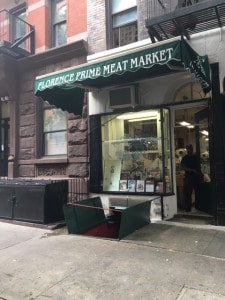
Marsala might be good cooking wine but the town had pulled its shutters down on a Sunday afternoon. What seemed like miles of low buildings showed us their blank faces as we drove through.
Trapani was a little livelier. A Facebook friend had told me you can take ferries to the offshore islands and there hire fishermen to take you to fine swimming spots. We thought, maybe next time.
But at Trapani directional confusion reared its head again. The city of almost half a million lies between the coast and the 2,400 foot mountain surmounted by medieval Erice.
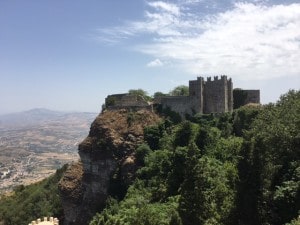
We planned to visit Erice but today we wanted to get around that mountain to the other side.
Our journey pointed to Scopello on the Golfo di Castellamarre. This was the town the Australians had told us about back on Ortigia.
We followed Hertz NeverLost’s disembodied voice into cul de sacs and back the way we came. Finally we stopped and Barbara asked directions. After that we found our way around the south side of the mountain to Valderice and eventually the turnoff to Scopello.
The narrow road soon brought us to the Golfo di Castellammare, a wide bay off the Tyrrhenian Sea. We drove past a pebbled beach filled with families swimming and sunning on a Sunday afternoon. The hotel where we were headed told us to look for the faraglioni, huge jagged rocks rising around a sheltered inlet.
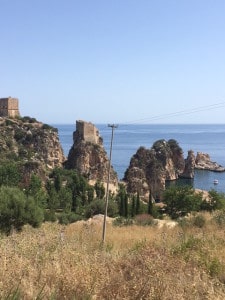
In fact Scopello, occupied since the Greeks ruled Sicily, got its name from those very rocks; the word for rock in Greek is scopelos.
We saw the rocks and took the next turn, as instructed. A narrow street led us to a corner of the town piazza where we turned into the Hotel Baglio Di Scopello. We’d reserved there for the next four nights. A few days on the beach seemed like a relaxing end to our vacation, and we thought we could use Scopello as a base to explore the surrounding area.
We unpacked and strolled down to the piazza. Kids kicked soccer balls, a young woman sat on a camp stool selling jewelry out of a backpack, and customers sat at tables scattered around a corner cafe. We ordered a snack and our usual vino bianco and began to rethink our plan.
Scopello was lovely but it wasn’t the beachfront paradise the Australian fellows had described. They had rented a villa overlooking the sea. We were in a town, in a room with a view.
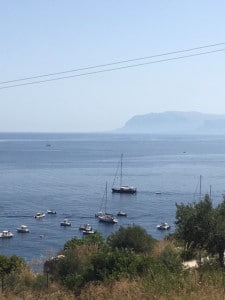
The town wasn’t that easy to get in and out of, making it a questionable base for further explorations. It was more of a place for families whose kids wanted to go swimming than for travelers who still had monuments and history to explore. Barbara suggested we let the hotel know we weren’t staying for four nights. I said we should sleep on it.
We investigated restaurant choices and came upon a rustic stone building with lots of potted plants and a wide, umbrella-shaded terrace that stretched to the edge of the hill overlooking the Golfo di Castellammare: the Ristorante La Terrazza.
We had a night view when we returned for dinner after 9 o’clock. Lights sparkled around the curving shoreline all the way to Punta Raisi, where planes were coming and going from Palermo’s airport.
Young couples nuzzled and held hands at some nearby tables. They were celebrating weddings, anniversaries, who knows what? Maybe just being in love. It filled the air, and infused the food.
Barbara ordered her new favorite, spaghetti bottarga or tuna eggs, and Nick had his favorite pasta con sarde, this time with bucatini, sardines and fennel. We both had grilled sea bream for our entrees.
The next morning was Monday July 11. We couldn’t believe we’d been in Sicily just over a week. We pondered our plans over breakfast under an umbrella in the hotel’s patio. Everybody we spoke with who had been to Sicily told us Erice was a must.
Before we left we told the hotel we’d be staying only one more night. “No,” we responded to the desk clerk’s questions, there was nothing wrong. We just had decided to pay more attention to Palermo. But sleeping on the decision cost us money. We’d reserved through booking.com and since we weren’t giving enough notice had to pay for one of the nights we weren’t using.
The narrow coastal road took us to the highway leading back toward Trapani. We passed a mountainside stone quarry, on our right, that research told us produced Perlato marble. At Valderice a sign pointed right toward Erice.
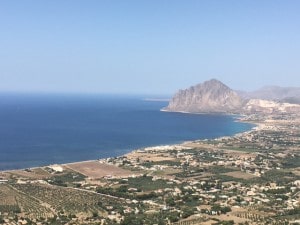
The road rose quickly once we cleared the town and soon we hit a series of sharp V turns up the mountainside. I told Barbara it would be a good road for a car race. Indeed, I learned that racers blast up the mountain every year in the Mount Erice Uphill Time Trial, one of the events in the Europe-wide Federation Internationale de l’Automobile Hill Climb Championship.
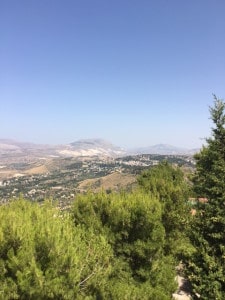
We didn’t set any speed records on the seven kilometer climb. But soon enough we reached a lot where we left the car and hit the streets of Erice on foot. This time, though, I (Nick) put euro coins and not my debit card in the parking machine to get my ticket.
We walked toward the summit on Via Vittorio Emanuele, which seems like the most common street name in Italy. Souvenir shops and restaurants crowded on both sides. We took side streets that took us higher, through piazzas with outdoor restaurants, museums, and Erice’s town hall. But we encountered more churches than anything else.
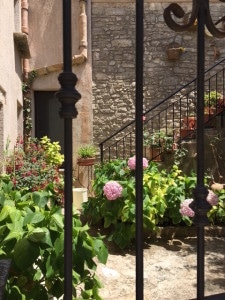
Erice offers a treasure of stories from before the Romans ruled Sicily. Fires lighted in a Carthaginian temple to Venus Eryx (one ancient name for Erice) on its mountaintop guided ships at sea. But the Erice that exists today is a creation of the Middle Ages, when a castle replaced the temple and workers built churches using local stone.
We passed the churches of San Giovanni, San Martino, San Giuliano (the name reminded us of New York’s former mayor, though not so much the saint part), San Pietro, San Cataldo, and San Domenico, and I’m sure we missed a few.
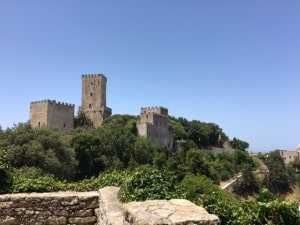
Erice is essentially a triangle, its tips pointed north, west, and east. The Castello di Venere, or Castle of Venus, stands at the eastern tip. Norman builders erected it in the 12th and 13th centuries atop the ruins of the Temple of Venus Eryx. You see it clinging to the sheer mountain walls and you have to salute its medieval engineers.
On the climb toward the castle an elderly woman, whose knees would put us all to shame for complaining, came walking downhill toward Barbara. For some reason both opened their arms to embrace, and the woman said to Barbara, “Che bella giornata!” Or, “What a beautiful day!” As we continued around the corner and up the next street, we heard a door open and another woman, in her fifties or sixties, stepped out onto the cobblestones, looked at Barbara, and began to complain. “E trope caldo! (It’s too hot!),” she said, vigorously fanning herself. She shook her head and added an exasperated, “La montagna detiene il calore.” Or, “The mountain holds the heat.” Somehow, Barbara understood her and nodded in agreement as we walked on.
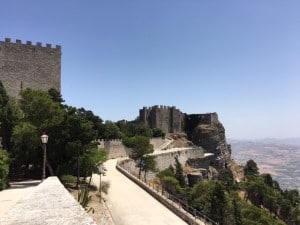
Just before we reached the castle, on the wide access road where you can stand at the edge and see Trapani and the Mediterranean Sea and even, on a clear day, Africa, we met a woman from Windsor, Ontario in Canada. Rose had brought her two sons, daughter-in-law and 93-year-old mother to Sicily. Her mother was from a village outside Palermo. This was the first time she had returned and Rose told us how neighbors came out and greeted the family, excited to meet her mother who had left long ago.
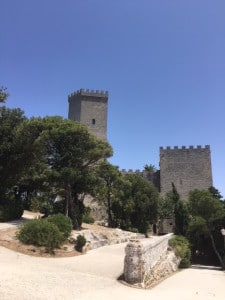
We found the castle and its grounds impressive but we can’t report on what’s inside, since it was closed. On the way down the mountain, we stopped for lunch at Il Vespro, a small restaurant behind a pizza place. We split an order of melon and prosciutto, and Barbara ordered couscous Trapanese, a local specialty that mixed seafood and a light spicy sauce with couscous. Nick chose calamari fritti and again, we enjoyed the local vino bianco.
Our last stop in Erice was at a stand selling, among other Sicilian keepsakes like hats and T-shirts, bags of coarse local sea salt. Finally, a souvenir we could use!
Back at Scopello, we decided to test the waters at the faraglioni swimming hole. We walked down the steep hill that reminded us of hiking up and down the dusty lower part of Ajax in Aspen. As we scrambled down the dirt path toward the water, we realized it was another bad idea. I (Nick) went back to get the car.
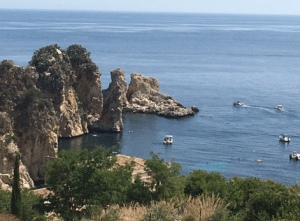
Barbara went on to get the tickets and found the only rude person we met in all of Sicily. When we looked, we found one TripAdvisor reviewer called her a “very unfriendly ill-mannered woman.” It cost 4 euros to enter the Tonnara di Scopello for a swim.
The tuna fishery that gave the place its name closed in the 1980s. Now, in if you plan in advance you can rent rooms there for a week, or hold events at the site.
We made another steep descent along a narrow path lined by ropes and sharply-worded warning signs to the water. There was no sand anywhere. Sunbathers lay on towels on the concrete and on beach chairs under a stretch of threadbare awning.
It looked unappealing but we’d made such an effort to get there and the spectacular view and the clear water compensated for the off-putting setup.
We tiptoed around dangerous rocks clustered at the water’s edge and swam in the warm sea. Boats anchored a short way offshore around the swimming hole. We looked at them wistfully thinking that a boat would the best way to visit this place. Turns out in Scopello proper, you can arrange a boat ride, snorkeling and scuba diving.
That night, we decided to stick with what we knew and returned to Ristorante La Terraza. We found booking in advance, even by a few hours, puts you at a table at the edge of the terrace with the spectacular view.
We tried a different local vino bianco and Nick ordered octopus, squid and celery antipasti.
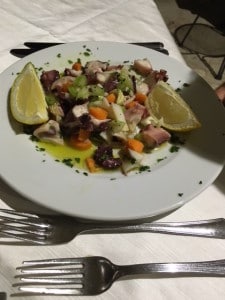
Barbara chose skewers of cuttlefish and shrimp.
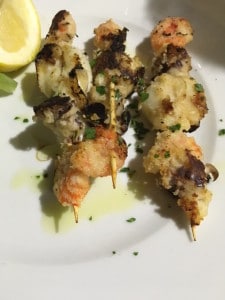
Nick picked, for his main, a simple grilled swordfish. He’d ordered it often, and Barbara at this point got snarky and wondered if his nose would grow to resemble the fish’s. “Why shop around when you’ve found perfection?” he muttered into his plate.
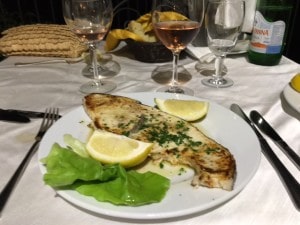
Barbara ordered swordfish too, but with tomato, eggplant and mint in caserecci. Nick prudently said nothing.
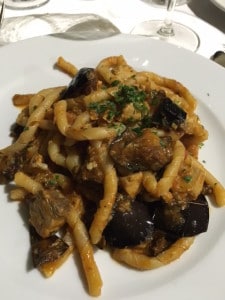
On Tuesday July 12. we enthusiastically headed for Palermo.
Sicily had outperformed all our expectations and we thought its capital, despite a reputation for petty street crime targeting tourists, would do the same. We hit the autostrada east of Castellammare del Golfo and breezed along the rocky grandeur of the seacoast broken by occasional beaches on our left.
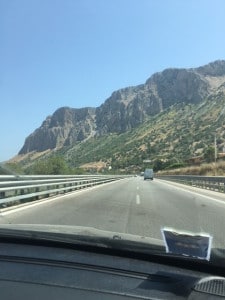
We had two goals for the day. One was to turn in our rental Fiat since we wouldn’t need it in the city. But before we did that we wanted to visit Monreale and the cathedral there to see the splendid mosaics. NeverLost finally gave us directions and we followed them off the autostrada toward the south side of Palermo.
Monreale today is a Palermo suburb hardly separate from the city. But when the Norman King William II built the cathedral there late in the 12th century, the 10 kilometer commute took more than a few minutes. The cathedral, or duomo, stands near the top of Mount Caputo, surrounded now by crowded, busy streets. We found a parking lot and left the car.
Everybody who has traveled to Italy has seen plenty of religious art. Yet the glories of Florence, Rome and Venice don’t prepare you for the golden mosaics inside Monreale’s Duomo.
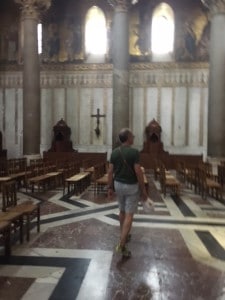
They cover almost the entirety of its interior and at 7,600 square meters — almost 82,000 square feet — they’re the most extensive such decoration anywhere.
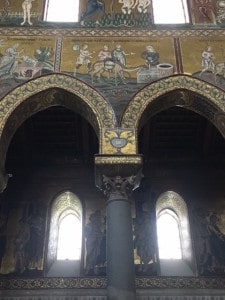
They tell in great detail the Christian story while the dominant figure of Christ Pantocrator — meaning roughly “omnipotent” — looks out at the scenes from the main apse above the altar.
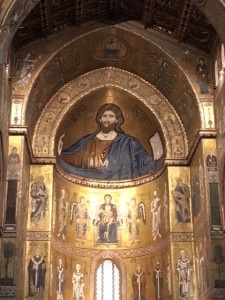
Everything shuts down, including the church at 12:45 (during the week) for almost two hours so that you can enjoy your lunch or nap. We walked the streets around the area, passing a few market stands and several outdoor cafes, before choosing a restaurant in a narrow alley mostly for its shade.
One of the servers looked just like Jessica Pare, who played Don Draper’s second wife Megan in “Mad Men.” When we told her that she looked like an American actress, she immediately looked it up. And she came back with the cook to thank us excitedly because it was “true.”
We had looked up Palermo’s Hertz offices and chose one that we thought was closest. The server confirmed it. You’d think NeverLost would at least have a homing instinct. We followed its directions to a train station and then along industrial streets to a huge Home Depot-like store called Leroy Merlin where, after we did some pitiful pleading, an employee went out the front door and pointed to a place across the street.
It took Barbara half an hour to learn that this Fiat dealer only rented Hertz trucks and commercial vehicles. The office we wanted was in the middle of Palermo. And that’s where we eventually found it with the help of one of the clerks there on the telephone.
A few minutes later, we piled with our bags into a taxi and were delivered to the Grand Hotel Piazza Borsa in Palermo’s historic center near the port. The hotel has big spaces that at first seem a little strange because part of it once housed a monastery, the other a bank and the owners combined the two. But it has an unbeatable location. It sits along along a vast piazza at the top of a warren of streets near the Kalsa, a district once the center of Muslim Palermo called Al-Khalisa, or the purest. Sound a little like “Game of Thrones?” We saw street signs in Italian, Arabic and Hebrew, insights into the city’s history.
After checking in, we sat in a bar off what had been the monastery’s cloister and enjoyed our evening vino bianco. Then we went out to look around. Actually, we (Nick) went out to shop for underwear.
Corso Vittorio, the main street passing the hotel, intersected nearby with a shopping street. I quickly learned that looking for traditional boxer shorts on Palermo’s Via Roma was like going into a pet shop and asking for a unicorn. After the shopping interlude, we returned to take the measure of the neighborhood.
We passed an art gallery. A photo exhibit hung on the walls and the people inside were talking and laughing. We went in and soon Mauro Filippi, the architect who had taken the photos, began to chat with us.
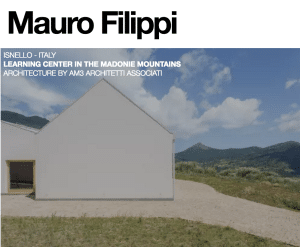
The photos explored shapes and contrasts of buildings in cities throughout the world. A few captured a pure light over a Sicilian beach. Barbara loved them.
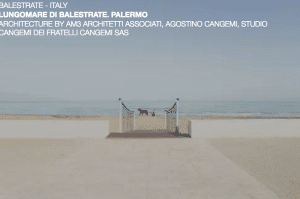
On the way out, we asked for a restaurant recommendation and he suggested Buatta, on Corso Vittorio not far from the hotel. In this busy restaurant, we (Nick) had the first bad meal in Sicily. The black-clad staff was friendly, the room was fine, and maybe it was my fault for ordering “beef Palermo-style” after a steady fish diet. But what arrived in front of me was simply inedible. The kitchen replaced it with some fish, also not so good. The Sicilian wine was as good as ever, but I was disappointed to learn that a bad Sicilian meal was even possible.
On Wednesday July 13, our last full day in Sicily, we had a mission to see the Palatine Chapel and the golden mosaics there that inspired those in Monreale’s cathedral.
The Norman kings who ruled Sicily commissioned the mosaics in both places. King Roger II gets the credit for the thinking that brought Byzantine artists to Palermo in the early 12th century. The creation of the mosaics and the Palantine Chapel figure in Barry Unsworth’s brilliant novel “The Ruby in Her Navel,” a story of intrigue and treachery among the Christians who resented King Roger for tolerating Jews and giving Muslims important positions in his kingdom. We fell in love with the book and the love story that makes it compelling reading.
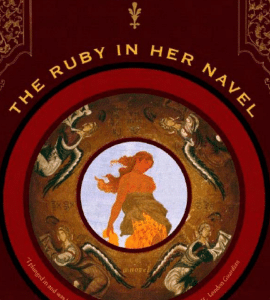
On our way to the Norman palace, we found that police had diverted car traffic along Corso Vittorio
Something was happening in the Piazza Pretoria and we went into the square to see what was going on. News cameras and a crowd taking pictures with their cell phones pressed around a Catholic archbishop, resplendent in a red cape and a red cap, going into city hall. The scene was deliciously ironic, since a huge fountain surrounded by nude statues dominates the Piazza Pretoria.
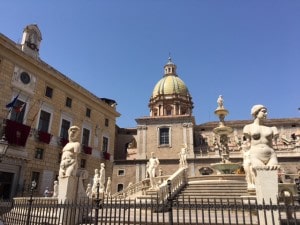
Installed in the 16th century when the mores of the Spanish Inquisition still dominated Sicily, the fountain and its frisky nudes soon earned the piazza a nickname, the “Square of Shame.”
We continued west on Corso Vittorio until we approached the Porta Nuova, the “new gate” that was built in 1570, and the grounds of the Norman castle.
The Palatine Chapel would fit in a corner of Monreale cathedral, but it almost leaves you speechless when you walk in. Art historians describe it as one of the wonders of the Middle Ages.
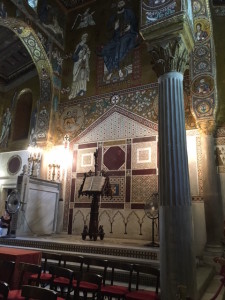
Again, gold dominates the color scheme of the mosaics that depict, in great detail, the story of Christianity. Christ Pantocrator looks down from above the altar. Byzantine artists created the early work that features Greek Christian Saints with inscriptions in Greek. The later mosaics use Latin, and historians suggest local craftsman did the work, which isn’t thought to be as fine as the earlier mosaics. Extraordinary nonetheless.
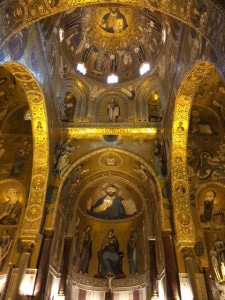
The carved wooden ceiling with its Arabic inscriptions, lions and eagles along with the geometric designs that adorn the walls highlight the Norman-Arab style that flourished under enlightened Norman rule.
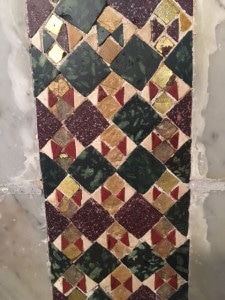
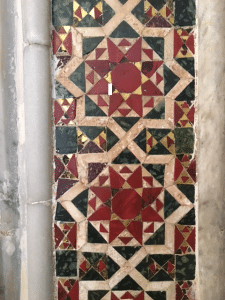
The Norman palace rooms were closed to visitors, so we took in an art gallery on the ground floor of the palace. “Torments and Enchantments” displayed the realistic animal paintings and self-portraits of Antonio Ligabue. His work provided a decompressing and yet fascinating contrast to what we had just seen.
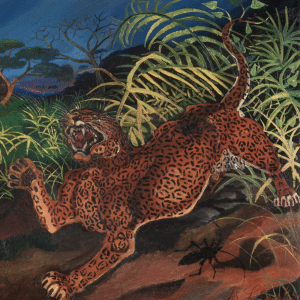
When we finished the gallery tour, our tired legs commanded that we take a taxi back to the historic center. Right away we encountered the same kind of hustler you see at the New York airports, a free lance taxi driver. We almost went with him but Barbara wisely and emphatically said, “No!” when we realized his car was not a taxi.
Then we found an official taxi stand and named a restaurant Barbara had chosen as our lunch spot. I smelled a rat when this driver started talking about the magnificent beach at Mondello, just west of Palermo, and the restaurants there. When he stopped in front of a restaurant– not the one we asked for — we objected and made him return to the first place. He kept his meter on but I refused to pay full fare. Call me a New Yorker.
Then it seemed the joke might be on us. The restaurant we wanted was closed. Then we spotted La Pesceria across the street.
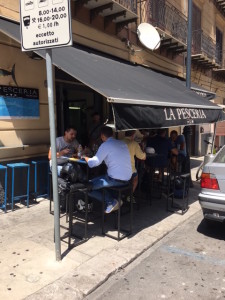
The small fish market features outside tables and a kitchen. The brothers who own it have a bar next door.
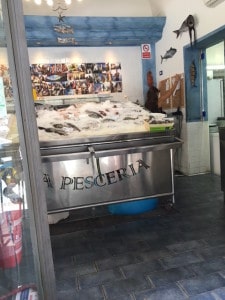 We hesitated to sit down, though. People were trying to revive a man who’d collapsed and was lying prostrate on the sidewalk. The owners took care of him and called an ambulance, and we found a corner table where the awning shaded us from the sun.
We hesitated to sit down, though. People were trying to revive a man who’d collapsed and was lying prostrate on the sidewalk. The owners took care of him and called an ambulance, and we found a corner table where the awning shaded us from the sun.
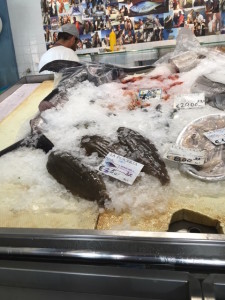
La Pesceria turned out to be a happy Palermo find .
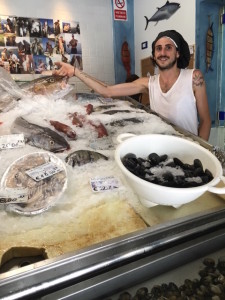 Chef Cristiano Carcolici came out of the kitchen to pose for a photo and insisted we understand that his brothers Andrea and Lorenzo play a big part in the business. Lorenzo’s girlfriend Maritza serves.
Chef Cristiano Carcolici came out of the kitchen to pose for a photo and insisted we understand that his brothers Andrea and Lorenzo play a big part in the business. Lorenzo’s girlfriend Maritza serves.
We sipped Sicilian vino bianco, ordered seafood insalta mixta, fried calamari, grilled swordfish and and a melange of fried seafood.
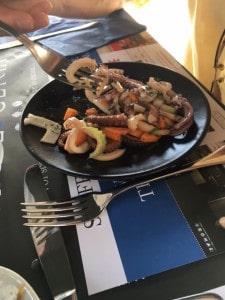
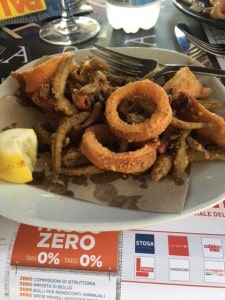
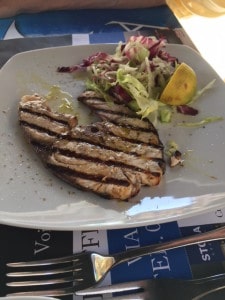 To burn off the lunch, we walked to the hotel during siesta time on the quiet streets with their shuttered shops.
To burn off the lunch, we walked to the hotel during siesta time on the quiet streets with their shuttered shops.
After our nap, we discovered Via Allesandro Paternoster, a street that curved around the back of the hotel through a part of the Kalsa district. It seemed like a small arts district with young craftspeople and designers making and selling leather goods and bags and clothing. Several secondhand clothing stores featured alluring vintage dresses, but Barbara wasn’t shopping.
The well-known Antica Foccaceria San Francesco has tables out in a square in front of the church of San Francesco d’Assisi, one of Palermo’s important historical churches. American Mafioso Charles “Lucky” Lucciano reportedly liked to eat there and and tourists filled the tables. But we joined the locals at one of the many wine bars on the street that lay in deep shade that broke the afternoon heat.
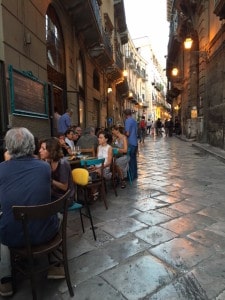
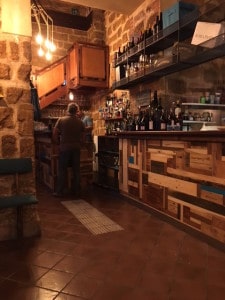
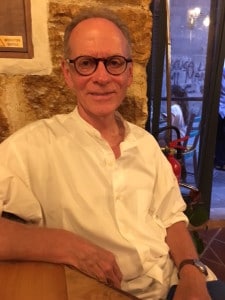
Via Paternoster joined Via Calascibetta at a place where a couple of homeless people camped. This street, paved with stones polished smooth from centuries of use, led back to the square in front of the hotel. It passed a restaurant called Osteria Ballaro. We peeked inside at its dramatic, high-ceilinged dining room, that once housed a stable, studied its artisanal Sicilian menu (is that a contradiction in terms?) and made a reservation.
It was a good choice. Barbara had Ballaro street food, a sampler featuring eggplant caponata, a slider of mystery meat, arincinetta with Girgentana goat cheese, potato balls, and fried dumpling-like things.
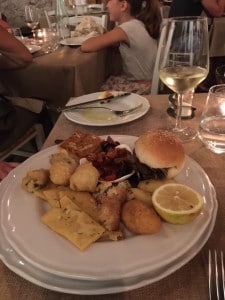
Nick went for something simpler, sea bass ravioli.with a light tomato broth, thin slices of squid and shaved almonds.
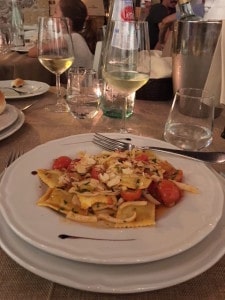
Barbara had what they called tagliatella di palazzo Cattolica.
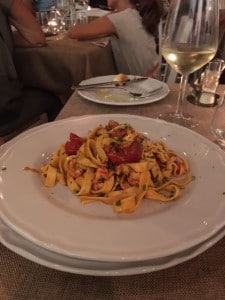
This was tagliatelli with shrimp, cherry tomatoes and pistachios. Nick ordered tuna with a pistachio crust for his main dish.
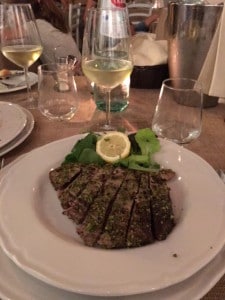
More Etna bianco made the meal perfect.
The light that woke us on departure day, Thursday July 14, was grey for the first time since we’d landed almost two weeks earlier. But it quickly cleared. And during our taxi ride to the airport at Punta Raisi, we marveled again at the beautiful Sicilian landscape — the undulating olive groves, sparse rocky hills plunging to the sea, crescents of beach, all making for drama that seemed barely contained.
At the Palermo airport more surprises. A piano sat in the middle of the departure area and a fellow traveler and his friends made the most of the waiting time.
Ryanair took us without drama to Madrid, where we ate dinner at Los Asturianos and stayed overnight at the Hotel Orfila (two of our favorite places), spent a couple of hours at the Prado, and then caught our late Air Europa flight home to JFK. In true Air Europa style, the flight left three hours late after the plane had to be fumigated for some kind of bugs. But it did leave.
We reached JFK around 10:30, got our bags, and wound up in a loose-limbed taxi with the loudest rattle that I’ve ever heard. Traffic inched into the south tube of the Midtown Tunnel; the north tube was closed for repairs. The ride home took a substantial fraction of the time we had spent flying from Madrid.
But in the end, the travel glitches faded in the afterglow of one of the best trips ever.
Photos and videos shot with iPhone 6S.
